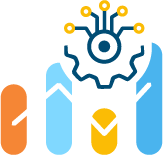Cutting costs in response to the economic downturn will only get organizations so far, and missing too much may create problems later. Therefore, organizations must take more-comprehensive action beyond the cost optimization actions typically considered. Successful organizations try to optimize costs and value and become increasingly smarter with resources. They balance investments targeted toward growth, focusing on digital business and efficiency.

Infrastructure and operations (I&O) leaders will do their best to go on the offensive by proactively managing the organization’s response. This requires making critical decisions now to avoid facing problems later on.
Machine learning for harnessing business growth
Machine learning has become a popular technology in recent years and has seen widespread adoption across various industries. The impactful use of relevant data is an essential and critical component to enable a business growth strategy. It often allows them to differentiate within their industries without massive resource investment. Technologies previously considered too complicated and expensive, such as artificial Intelligence and machine learning, are now viable. These days, we are putting the tools needed to derive essential insights into the hands of technology leaders across companies of all types and sizes.
The rise of Machine Learning and MLOps
With the rise of machine learning, the demand for computational resources has also increased, leading to higher infrastructure costs. Efficient management of machine learning processes can help reduce these costs significantly. This is where MLOps, or automated machine learning operations, come into play.
MLOps manages and governs machine learning processes, from model development to deployment, to ensure the best possible performance and efficiency. One of the main objectives of MLOps is to optimize Machine Learning infrastructure, which includes the infrastructure management of resources such as compute, storage, and networking, effectively maximizing Machine Learning (ML) workloads.
According to a recent Gartner article entitled “Use Gartner’s MLOPs Framework to Operationalize ML Projects,” to achieve long-term machine learning project success, data and analytics leaders responsible for Artificial Intelligence (AI) strategy should:
- Establish a systematic machine learning operationalization (MLOps) process.
- Review and revalidate Machine Learning model operational performance by ensuring they meet integrity, transparency, and sustainability goals.
- Minimize the technical debt and maintenance procedures by implementing DevOps practices on a person and process level.
Efficient machine learning management can easily reduce infrastructure costs
In several ways, efficient management of machine learning processes can reduce infrastructure costs. Below we list some of the most critical ways:
- ML optimization: Machine Learning optimization involves tuning and improving the performance of ML models. One of the most significant costs associated with machine learning is the cost of model training. By optimizing ML models, it’s possible to reduce the number of resources required for activity, resulting in reduced infrastructure costs.
- ML profiling: ML profiling involves analyzing the performance of ML models to identify bottlenecks and areas of improvement. ML profiling can help identify inefficiencies in the Machine Learning infrastructure, such as underutilized resources, and help optimize the usage of these.
- ML model profiling: Machine Learning model profiling involves analyzing the performance of individual ML models to identify areas that can be optimized. By identifying the most significant contributors to cost, ML model profiling can help determine which models require more resources and which can be used more efficiently.
- ML Flow: Machine Learning Flow is a tool for managing and tracking the entire machine learning workflow. By using ML Flow, teams can improve collaboration and reduce the risk of errors – which can lead to higher infrastructure costs.
- Infrastructure Management: This relates to managing resources required to run machine learning workloads. By managing infrastructure more efficiently, teams can reduce the cost of running Machine Learning workloads.
- Auto-scaling: Auto-scaling is the practice of automatically adjusting resources to match the needs of machine learning workloads. By automating the scaling process, teams ensure that resources are used more efficiently.
MLOps for infrastructure management
MLOps tools like OptScale can help teams manage infrastructure more efficiently. OptScale provides infrastructure optimization for machine learning workloads, assisting the teams in reducing the cost of cloud resources and ensuring that resources are used efficiently and cost-effectively.
OptScale provides several features that help reduce infrastructure costs during the machine learning process, including:
- Resource optimization: Helping to reduce the cost of cloud resources.
- Auto-scaling: Allowing the system to scale up or down the resources as needed.
- Containerization: Features that enable the system to package machine learning workloads into containers, reducing the resources required.
- Cloud provider optimization: Features that optimize cloud provider and instance type selections.
In conclusion
The efficient management of ML processes is crucial for reducing infrastructure costs. By optimizing resource allocation, scheduling jobs during off-peak hours, containerizing processes, and monitoring and optimizing performance, companies can reduce the overall infrastructure costs associated with ML without sacrificing performance or functionality. To further reduce infrastructure costs, companies can leverage the OptScale solution which gives an opportunity to run ML/AI or any type of workload with optimal performance and infrastructure cost by profiling ML jobs, running automated experiments, and analyzing cloud usage.
To learn more about how OptScale can help your organization, watch a live demo today.
💡 You might be also interested in our article ‘What are the main challenges of the MLOps process?’
Discover the challenges of the MLOps process, such as data, models, infrastructure, and people/processes, and explore potential solutions to overcome them →
✔️ OptScale, a FinOps & MLOps open source platform, which helps companies optimize cloud costs and bring more cloud usage transparency, is fully available under Apache 2.0 on GitHub →




